Wikipedia:Picture of the day/June 2014
|
Featured picture tools: |
These featured pictures, as scheduled below, appeared as the picture of the day (POTD) on the English Wikipedia's Main Page in June 2014. Individual sections for each day on this page can be linked to with the day number as the anchor name (e.g. [[Wikipedia:Picture of the day/June 2014#1]] for June 1).
You can add an automatically updating POTD template to your user page using {{Pic of the day}} (version with blurb) or {{POTD}} (version without blurb). For instructions on how to make custom POTD layouts, see Wikipedia:Picture of the day.Purge server cache
June 1
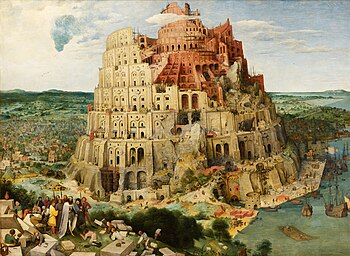
|
The Tower of Babel, held at the Kunsthistorisches Museum in Vienna, is a painting by Pieter Bruegel the Elder that was completed circa 1563. It depicts the construction of the Tower of Babel, which according to the Book of Genesis in the Bible, was a tower built by a unified, monolingual humanity as a mark of their achievement and to prevent them from scattering. Bruegel completed a second painting of the same subject, known as the The "Little" Tower of Babel, at roughly the same time; it is held in the Museum Boijmans Van Beuningen in Rotterdam. Painting: Pieter Bruegel the Elder
Recently featured:
|
June 2

|
A nest of the tropical Asian giant honey bee, which consists of a single exposed honeycomb, an array of densely packed hexagonal cells made of beeswax. Honeycombs store food (honey and pollen) and house the "brood" (eggs, larvae, and pupae). Photograph: Muhammad Mahdi Karim
Recently featured:
|
June 3

|
Three structures on Matanaka Farm (from left to right: the granary, privy and schoolhouse), the oldest surviving farm buildings in New Zealand that are still in their original positions. Established by the Australian whaler Johnny Jones in 1838, the construction of the farm's structures began in 1840. After passing through several families, the site is now owned and administered by the New Zealand Historic Places Trust. Photograph: Karora
Recently featured:
|
June 4
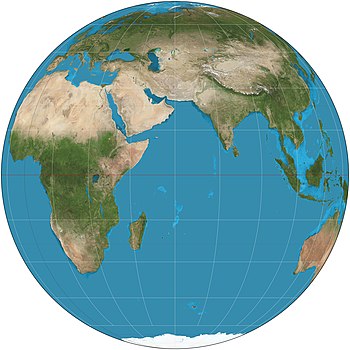
|
An orthographic projection of the Eastern Hemisphere from 30W–150E, based on NASA's The Blue Marble. The orthographic projection, a map projection used in cartography, depicts a hemisphere of the globe as it appears from outer space, where the horizon is a great circle. It is a perspective (or azimuthal) projection, in which the sphere is projected onto a tangent plane or secant plane with parallel rays, as if seen from an infinite distance. The shapes and areas are distorted, particularly near the edges. Map: Strebe, using Geocart
Recently featured:
|
June 5

|
The Song of Los is an epic poem by William Blake first published in 1795 and considered part of his prophetic books. The poem consists of two sections, "Africa" and "Asia": in the first section Blake catalogues the decline of morality in Europe, which he blames on both the African slave trade and enlightenment philosophers, whereas in the second section he describes a worldwide revolution, urged by the eponymous Los. The illustration here is from the book's frontispiece and shows Urizen presiding over the decline of morality. Illustration: William Blake
Recently featured:
|
June 6
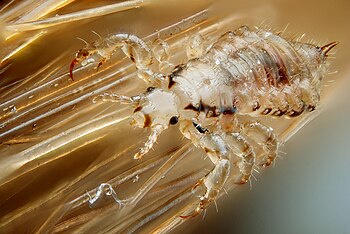
|
A male head louse, an obligate ectoparasitic insect which spends its entire life on the human scalp and feeds exclusively on human blood. It is one of three louse species which infects humans, along with the body louse and the crab louse. Head lice infestation is widely endemic, especially in children, and treatment of such infestations is not 100% effective; the lice themselves, however, are not disease vectors, and it has been suggested that they are beneficial to the body. Photograph: Gilles San Martin
Recently featured:
|
June 7

|
The sanderling (Calidris alba) is a small wading bird, a circumpolar Arctic breeder which migrates south during the winter. Sanderlings feed mostly on small invertebrates, particularly crustaceans and insects, although they may eat plant material. This individual was found in Laem Phak Bia, Phetchaburi, Thailand. Photograph: JJ Harrison
Recently featured:
|
June 8

|
Adansonia digitata is a sub-Saharan African species of baobab tree. The genus, scientifically known as Adansonia, consists of nine species native to Madagascar, Africa, Arabia and Australia, and can reach heights of 5 to 30 m (16 to 98 ft) with trunk diameters of 7 to 11 m (23 to 36 ft). Photograph: Muhammad Mahdi Karim
Recently featured:
|
June 9

|
Workers load uranium slugs into the X-10 Graphite Reactor's concrete face. Built as part of the Manhattan Project, X-10 was the first-ever production reactor, and acted as a proof of concept for the reactors that would produce materials for the first nuclear bombs. The concrete face is 44 by 44 feet (13.4 by 13.4 metres). Part of the Oak Ridge National Laboratory in Oak Ridge, Tennessee, since 1966 it has been a designated National Historic Landmark. Photograph: Ed Westcott / US Army
Recently featured:
|
June 10

|
|
A night-time view of the Speicherstadt in Hamburg, Germany. Literally meaning "city of warehouses", the Speicherstadt was built from 1883 to 1927 and was intended as a free zone in which goods could be transferred without paying customs charges. It is the largest warehouse district in the world in which the buildings stand on timber-pile foundations. Photograph: Thomas Wolf
Recently featured:
|
June 11

|
A color visual interpretation of the digital signal in the Arecibo message, sent in 1974 from the Arecibo Observatory. Broadcast into space via frequency modulated radio waves at a ceremony to mark the remodeling of the Arecibo radio telescope in Puerto Rico, the message consisted of 1,679 binary digits, approximately 210 bytes, transmitted at a frequency of 2,380 MHz. It was aimed at the Great Globular Cluster in Hercules, some 25,000 light-years away, and contains information related to mathematics, chemistry, and astronomy. Graphic: Arne Nordmann
Recently featured:
|
June 12

|
The Lötschberg railway line is a major railway through the Swiss Alps, which connects Spiez in the Bernese Oberland with Brig in the Valais. The railway, opened on 15 July 1913, reaches a maximum height of 1,240 m (4,068 ft) above sea level. Photograph: David Gubler
Recently featured:
|
June 13

|
An illustration showing the garden at Somersby Rectory in Somersby, Lincolnshire, where the English poet Alfred Tennyson was born and raised. The village's influence is visible in Tennyson's work, and the British literary scholar Christopher Ricks relates the following lines from In Memoriam A.H.H., describing Tennyson's abandonment of once-loved places after the death of his friend, to the rectory: Unwatched, the garden bough shall sway, This illustration by William Edward Frank Britten served as frontispiece to a 1909 anthology of Tennyson's works. Illustration: William Edward Frank Britten; restoration: Adam Cuerden
Recently featured:
|
June 14
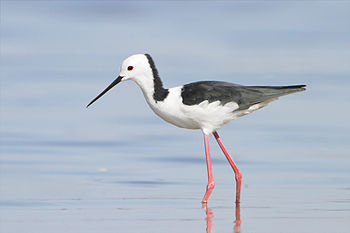
|
A white-headed stilt (Himantopus leucocephalus) in Lake Joondalup, Perth. The white-headed stilt is sometimes considered a subspecies of the black-winged stilt. Photograph: JJ Harrison
Recently featured:
|
June 15

|
Mumtaz Ahmed Khan is an Indian humanitarian. A surgeon by trade, in 1966 he established the Al-Ameen Educational Society; it now operates eight schools in the Bangalore area. Photograph: Muhammad Mahdi Karim
Recently featured:
|
June 16

|
An animation of the eclipsing binary star Algol, assembled from 55 images of the CHARA interferometer in the near-infrared H-band, sorted according to orbital phase; because some phases are poorly covered, Algol B appears to jump at some points along its path around Algol A. A third star in the system is outside the frame. Algol's characteristics have led to a star class and an apparent paradox being named after it. Animation: Dr. Fabien Baron; University of Michigan
Recently featured:
|
June 17
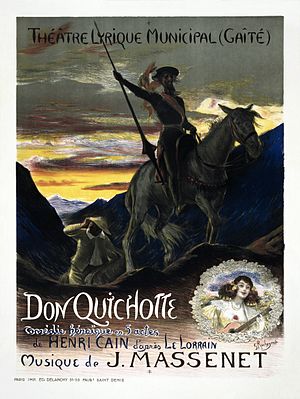
|
A poster for the Paris premiere of Jules Massenet's 1910 opera Don Quichotte at the Gaîté-Lyrique. Loosely based on Cervantes' novel Don Quixote, this opera in five acts follows the eponymous knight as he attempts to retrieve a necklace and win the love of the beauty Dulcinée. The opera was scored to a French libretto by Henri Caïn. Poster: Georges Rochegrosse; restoration: Adam Cuerden
Recently featured:
|
June 18

|
The ULPower UL260i, a flat-four engine produced by ULPower Aero Engines of Belgium. Flat-four engines are flat engines with four cylinders arranged horizontally in two banks of two cylinders on each side of a central crankcase; they can be used in cars, motorcycles, or aircraft. This type of engine tends to be well-balanced and have efficient cooling, but is expensive to manufacture and considerably wider than other engines. Photograph: ULPower Aero Engines
Recently featured:
|
June 19

|
Bryaninops yongei is a benthic species of goby widely distributed throughout the tropical and subtropical waters of the Indian Ocean; it is commonly found living in and around coral. Although this species was discovered in 1906, its ability to propel itself quickly to escape predators makes it difficult to study. Photo: Nick Hobgood
Recently featured:
|
June 20

|
The prototype Space Shuttle Enterprise in free flight during its second Approach and Landing Test at the Dryden Flight Research Center in Edwards Air Force Base, California, in 1977. The series of taxi and flight trials tested the shuttle's flight characteristics, both on its own and when mated to the Shuttle Carrier Aircraft. The aerodynamic tail cone visible in this image was intended to reduce its drag in the mated configuration. Photo: NASA
Recently featured:
|
June 21

|
|
Wulingyuan is a UNESCO World Heritage Site in Hunan, China, which was designated in 1992. It consists of more than 3,000 quartzite sandstone pillars, many over 200 metres (660 feet) in height, as well as caves, streams, pools, waterfalls, and two natural bridges. Pictured here is Five Fingers Peak. Photo: Chensiyuan
Recently featured:
|
June 22

|
A pair of ruddy shelducks (Tadorna ferruginea) in Springe, Hanover. This shelduck species lives in the open country and is usually found in pairs, though large groups may form moulting and wintering gatherings. Photo: Michael Gäbler
Recently featured:
|
June 23

|
Olympia is an oil painting on canvas by Édouard Manet which was completed in 1863 and measures 130.5 by 190 centimetres (51 x 74.8 in). Olympia caused controversy when first exhibited at the 1865 Paris Salon, owing to the subject's confrontational glare and adornment with details identifying her as a prostitute. The nation of France acquired the painting in 1890 after a public subscription organized by Claude Monet. The painting is now on display at the Musée d'Orsay, Paris. Painting: Édouard Manet; edit: Crisco 1492
Recently featured:
|
June 24
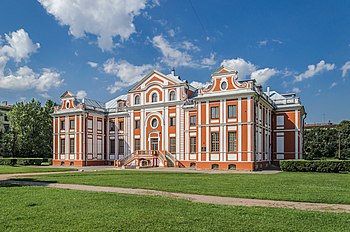
|
Kikin Hall, commissioned by Alexander Kikin in 1714, is one of the oldest buildings in Saint Petersburg. Incomplete at the time of Kikin's execution, the building was seized by the Russian crown and used for a variety of purposes. In the 1950s, Irina Benois arranged for the restoration of the dilapidated building. It is now home to a music school. Photograph: Florstein
Recently featured:
|
June 25
Subpage 1

|
The Hawaii overprint notes, an emergency issue of U.S. currency overprinted with the word Hawaii, became the only bills allowed to be used there following the attack on Pearl Harbor. Any money captured by the Japanese if they invaded Hawaii could then be easily distinguished. The bills were introduced on June 25, 1942, and withdrawn effective April 1946; many were destroyed. Shown here is a $1 Silver Certificate, of which 35,052,000 were printed. This bill is scanned from the collections of the National Numismatic Collection at the Smithsonian Institution.
Banknote: Bureau of Engraving and Printing (image courtesy of the Smithsonian Institution)
Recently featured:
|
Subpage 2

|
The Hawaii overprint notes, an emergency issue of U.S. currency overprinted with the word Hawaii, became the only bills allowed to be used there following the attack on Pearl Harbor. Any money captured by the Japanese if they invaded Hawaii could then be easily distinguished. The bills were introduced on June 25, 1942, and withdrawn effective April 1946; many were destroyed. Shown here is a $5 Federal Reserve Note, of which 9,416,000 were printed. This bill is scanned from the collections of the National Numismatic Collection at the Smithsonian Institution.
Banknote: Bureau of Engraving and Printing (image courtesy of the Smithsonian Institution)
Recently featured:
|
Subpage 3

|
The Hawaii overprint notes, an emergency issue of U.S. currency overprinted with the word Hawaii, became the only bills allowed to be used there following the attack on Pearl Harbor. Any money captured by the Japanese if they invaded Hawaii could then be easily distinguished. The bills were introduced on June 25, 1942, and withdrawn effective April 1946; many were destroyed. Shown here is a $10 Federal Reserve Note, of which 10,424,000 were printed. This bill is scanned from the collections of the National Numismatic Collection at the Smithsonian Institution.
Banknote: Bureau of Engraving and Printing (image courtesy of the Smithsonian Institution)
Recently featured:
|
Subpage 4

|
The Hawaii overprint notes, an emergency issue of U.S. currency overprinted with the word Hawaii, became the only bills allowed to be used there following the attack on Pearl Harbor. Any money captured by the Japanese if they invaded Hawaii could then be easily distinguished. The bills were introduced on June 25, 1942, and withdrawn effective April 1946; many were destroyed. Shown here is a $20 Federal Reserve Note, of which 11,246,000 were printed. This bill is scanned from the collections of the National Numismatic Collection at the Smithsonian Institution.
Banknote: Bureau of Engraving and Printing (image courtesy of the Smithsonian Institution)
Recently featured:
|
June 26

|
Dioctria atricapilla is a species of robber fly in the subfamily Dasypogoninae. Measuring 9–12 mm (0.35–0.47 in) in length, with a 7–9 mm (0.28–0.35 in) wingspan, it feeds mainly on smaller flies and predatory hymenopterans. Photo: Richard Bartz
Recently featured:
|
June 27

|
A portrait of a Jicarilla Apache man, taken by Edward S. Curtis in 1904. The Jicarilla, who refer to themselves as Tinde or Dinde (meaning "The People"), were originally a nomadic people who lived in the area around what is now Colorado and New Mexico. Interaction with Europeans starting in the 1700s led to the Jicarilla being forced off their sacred lands, and the following two centuries were filled with strife, including a battle against the US 1st Cavalry Regiment. By the time of this photograph, the Jicarilla had abandoned their nomadic ways and were living on a reservation; the land of the reservation was not fit for agriculture and malnutrition and tuberculosis were widespread. Photo: Edward S. Curtis; restoration: Keraunoscopia
Recently featured:
|
June 28

|
The Church of Saint Ildefonso in Porto, Portugal, is a Catholic church completed in 1739 to replace a centuries-old chapel. This octagonal church building is constructed of granite, and on its façade are 11,000 azulejo tiles installed by Jorge Colaço in 1932. The architect of the church is unknown. Photo: Diego Delso
Recently featured:
|
June 29

|
Salvin's albatross (Thalassarche salvini) is a large seabird that can be found across the Southern Ocean. Long considered to be a subspecies of the shy albatross, from the mid-1990s experts began classifying it as a separate species. The species' population is thought to be declining, and the IUCN has classified it as vulnerable. Photo: JJ Harrison
Recently featured:
|
June 30

|
|
A map of the United States Naval Academy, as it appeared in 1924. Established in 1845, the service academy educates and prepares officers for commissioning into the United States Navy and the United States Marine Corps. During the 1920s, the academy's athletics program began its era of success, taking a gold medal at the 1920 Summer Olympics and tying the University of Washington in the 1924 Rose Bowl. Map: C.E. Miller; restoration: Awardgive
Recently featured:
|
Picture of the day archives and future dates
